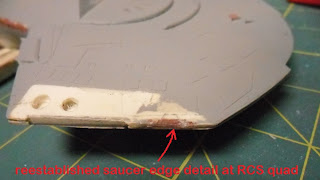A major reason I bought this kit was that I already had the Fruil tracks for it. Someone had tossed them into the table of parts for the Iron Modeler competition at Wonderfest. The stuff was free to all takers once the competition was concluded. Since I build armor also, I snatched these up.
At right you see the assembly fixture, followed by a picture in which I demonstrate how to use the fixture. These tracks are not what I expected: there is no wire to form track pins. Instead, the track pins are cast as part of each link. The part of each link that is like a hinge barrel is open so it can trap the pin in the next link. You place the assembly on the fixture and press the open barrel shut (here I'm doing it with a jeweler's screwdriver), and you get workable track.
Here's one run of track test fitted on the tractor. They look pretty good here, but I had to cut out a couple links in which the pins broke, probably because I closed the links together with too much force. PMMS has a review of Fruil's track set for the RSO, but it's for a new version, which confusingly has the same number of ATL-29. The differences are that the new links are more accurate, that they have wire for link pins and bolt head parts to make right- and left-hand tracks, and that sprockets are included. The new set apparently takes 69 links per run. I don't have the Panzer Tracts for the RSO, so I don't know how many links it should take. I looked at the best photo I could find of a real RSO and tried to count the number of links, and it seemed to be 72. The run I assembled took 67 links.
Since there are two versions of Fruil's track set ATL-29, you may get the old set when you think you're ordering the new set. However, I'm pretty happy with the old set. They are a bit wider to fit the wider kit sprockets, but the difference in width is kind of hard to see. Once I got the hang of assembling them, it was a breeze. True, the bolt heads on the link pins aren't there, but to my eye these are too large on the new track set. All in all, I don't see a lot of reason to prefer the new set over the old.














































